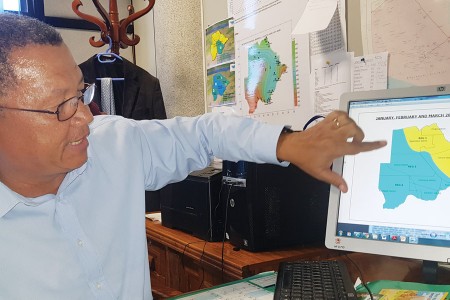The rains will fall but Ts and Cs apply
Mbongeni Mguni | Friday December 20, 2019 12:47


Farmers are a notoriously philosophical lot. In their defence, any activity that involves spending a lot of time watching the sky for rain tends towards one becoming a deep thinker. Farmers know all about the Ts and Cs of life, that few things are entirely good or entirely bad. Life is in the grey areas, the taking the good with the bad.
This is what happened the last time the country received rainfall sufficient for crop production in 2016/17. The rains were not evenly spread out across the season to support cropping, but rather fell in one swoop via February 2017’s Cyclone Dineo.
The deluge was heavy and came after a period of dryness, but in keeping with life’s Ts and Cs, while the waters boosted production in some areas, the heavy amounts also washed away some seedlings and plantlings elsewhere, worsening output.
This season, farmers will deal with another T and C. Experts at the Department of Meteorological Services this week unveiled their forecast for the critical January to March period, showing that most areas of the country should receive normal to above normal rains.
However, they will also have to cope with above normal temperatures, including heatwaves, for most of that period, dealing a blow to sensitive crops such as maize. “It is going to be hot between January and March even with the rains,” principal meteorologist, John Stegling told Mmegi this week.
“Maize dies with temperatures above a certain level, while sorghum, millet and others are hardier. “We are expecting normal to above normal temperatures between January and March, which is a trend that has been taking place in recent years. “There is a likelihood of heatwaves in certain areas, especially between January and February.” With the first half of the season having blessed most of the country with abundant rains allowing the start of agricultural activities such as tillage and planting, focus has shifted to the second half where crop maturation takes place. According to the Met Services department, nearly all areas in the country should receive normal to above normal rainfall, except for the North and North-East areas.
However, even here, there are Ts and Cs.
“The normal to above normal are specific to those areas. So for instance, 120 millimetres in Kgalagadi is above normal while 200 millimetres in Chobe is below normal. “Gaborone has received 244 millimetres of rainfall from the beginning of the season to date which has not been since in several years, but this is not above normal rain. It’s actually within the normal rainfall range. “We have actually been witnessing below normal rainfall in the Gaborone area for many years.”
The good news for most farmers is that the good rains in the first half of the season mean the reduction in the North and North East and expected higher temperatures, will come when more crops have had a better start than previous seasons.
The positive outlook in terms of rain, however, flies against other regional forecasts made by organisations such as the Famine Early Warning Systems Network and Global Agricultural Monitoring. Both these organisations, which are supported in terms of data and technology, by some of the world’s foremost climate experts expect Botswana to fall within a range of Southern African states that will experience poor rainfall between January and March 2020.
SADC’s Climate Services Centre, which traditionally issues the mid-season update taken by countries as authoritative, did not meet on the review this season due, reportedly, to lack of funds.
The situation has left farmers with another T and C conditionality. The rains will be great, if the local Met Services department is right or terrible if the other organisations are correct. For Stegling, there is no doubt about the accuracy of the locally produced forecast.
For farmers, January to March will be another period of watching the skies and contemplating.
